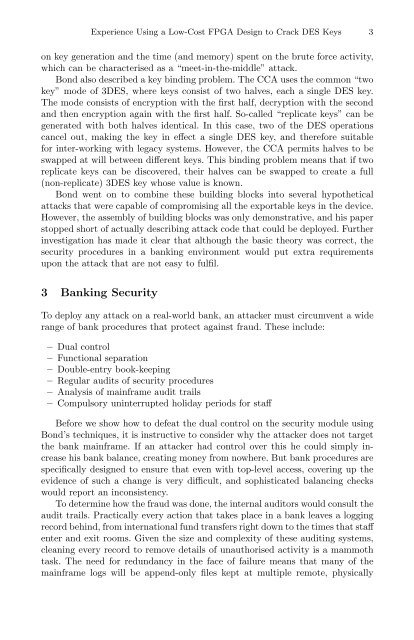Experience Using a Low-Cost FPGA Design to Crack DES Keys
Experience Using a Low-Cost FPGA Design to Crack DES Keys
Experience Using a Low-Cost FPGA Design to Crack DES Keys
Create successful ePaper yourself
Turn your PDF publications into a flip-book with our unique Google optimized e-Paper software.
<strong>Experience</strong> <strong>Using</strong> a <strong>Low</strong>-<strong>Cost</strong> <strong>FPGA</strong> <strong>Design</strong> <strong>to</strong> <strong>Crack</strong> <strong>DES</strong> <strong>Keys</strong> 3on key generation and the time (and memory) spent on the brute force activity,which can be characterised as a “meet-in-the-middle” attack.Bond also described a key binding problem. The CCA uses the common “twokey” mode of 3<strong>DES</strong>, where keys consist of two halves, each a single <strong>DES</strong> key.The mode consists of encryption with the first half, decryption with the secondand then encryption again with the first half. So-called “replicate keys” can begenerated with both halves identical. In this case, two of the <strong>DES</strong> operationscancel out, making the key in effect a single <strong>DES</strong> key, and therefore suitablefor inter-working with legacy systems. However, the CCA permits halves <strong>to</strong> beswapped at will between different keys. This binding problem means that if tworeplicate keys can be discovered, their halves can be swapped <strong>to</strong> create a full(non-replicate) 3<strong>DES</strong> key whose value is known.Bond went on <strong>to</strong> combine these building blocks in<strong>to</strong> several hypotheticalattacks that were capable of compromising all the exportable keys in the device.However, the assembly of building blocks was only demonstrative, and his papers<strong>to</strong>pped short of actually describing attack code that could be deployed. Furtherinvestigation has made it clear that although the basic theory was correct, thesecurity procedures in a banking environment would put extra requirementsupon the attack that are not easy <strong>to</strong> fulfil.3 Banking SecurityTo deploy any attack on a real-world bank, an attacker must circumvent a widerange of bank procedures that protect against fraud. These include:– Dual control– Functional separation– Double-entry book-keeping– Regular audits of security procedures– Analysis of mainframe audit trails– Compulsory uninterrupted holiday periods for staffBefore we show how <strong>to</strong> defeat the dual control on the security module usingBond’s techniques, it is instructive <strong>to</strong> consider why the attacker does not targetthe bank mainframe. If an attacker had control over this he could simply increasehis bank balance, creating money from nowhere. But bank procedures arespecifically designed <strong>to</strong> ensure that even with <strong>to</strong>p-level access, covering up theevidence of such a change is very difficult, and sophisticated balancing checkswould report an inconsistency.To determine how the fraud was done, the internal audi<strong>to</strong>rs would consult theaudit trails. Practically every action that takes place in a bank leaves a loggingrecord behind, from international fund transfers right down <strong>to</strong> the times that staffenter and exit rooms. Given the size and complexity of these auditing systems,cleaning every record <strong>to</strong> remove details of unauthorised activity is a mammothtask. The need for redundancy in the face of failure means that many of themainframe logs will be append-only files kept at multiple remote, physically












![Data Structures and Algorithms in Java[1].pdf - Fulvio Frisone](https://img.yumpu.com/30982515/1/190x245/data-structures-and-algorithms-in-java1pdf-fulvio-frisone.jpg?quality=85)
![(Microsoft PowerPoint - Topic 4.ppt [Mode de compatibilit\351])](https://img.yumpu.com/30966934/1/190x245/microsoft-powerpoint-topic-4ppt-mode-de-compatibilit351.jpg?quality=85)

